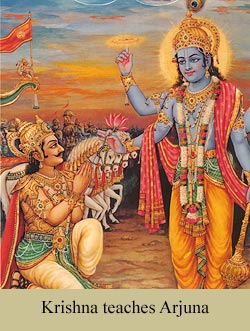 It is time for us to understand who the figure of Krishna really is–and what the Gita really is, as well.
It is time for us to understand who the figure of Krishna really is–and what the Gita really is, as well.
First we must understand the context of the Gita. The Gita is seven hundred verses within an epic poem known as The Mahabharata, that chronicles the Mahabharata (Great Indian) War that took place about three thousand years ago (according to the calculations of Swami Sri Yukteswar Giri).
The original poem was written by the great sage Vyasa, perhaps the single most important figure in Indian spiritual history. The Bhagavad Gita is the supreme scripture of India, for it is the essence of all the basic texts that came before it.
Further, it supplies a psychological side to spiritual practice that can be found in no other authoritative text. If someone desires, he can confine his study to the Gita alone and yet know everything that is in those texts. Although it contains some references to elements distinctly Indian, it is the only universal scripture, its teachings being relevant to the entire human race.
History or Philosophy?
Having said that, we must realize that although the Gita takes the form of a conversation between Krishna and Arjuna on the eve of the Great Indian War, it is not a historical document in the literal sense. Rather, Vyasa chose this critical juncture in Indian history as the setting for a complete exposition of spiritual life–itself a battle of sorts.
It cannot reasonably be thought that Krishna and Arjuna sat in a chariot in the midst of a battlefield discussing all the topics presented in the Gita–and in metrical stanzas of four lines containing eight syllables each (and sometimes eleven syllables when Vyasa needed the extra length to get in all his ideas).
Rather, the Gita is Vyasa’s presentation of the Eternal Dharma, though there is no reason to doubt that the wisdom of Krishna is embodied in it, or that much of it–at least in general–was spoken to Arjuna at Kurukshetra.
Vyasa’s masterpiece
One of India’s greatest yogis in the twentieth century was Paramhansa Nityananda of Ganeshpuri. One day someone cited a portion of the Gita, prefacing it with the statement: “Krishna said in the Gita….” Immediately Nityananda said: “No. Vyasa said Krishna said….” This is the correct perspective on the entire Gita.
What we are reading is the enlightened understanding of Vyasa, who in the Gita is presenting us with a digest of the yoga philosophy of the upanishads combined with both yoga psychology and instruction in yoga meditation. If all other scriptures and commentaries disappeared and only the Gita remained, the Eternal Dharma would still be intact and suffer no loss whatsoever. That is why once a year on Vyasa Purnima he is to be honored.
Vyasa, Krishna, Atman and Paramatman
In general, then, Krishna is the voice of Vyasa, but within the Gita he is at times the voice of both the Atman and the Paramatman. So when we ponder the meaning of his words we should consider how they might be understood in this dual manner.
For example, when Krishna tells us to fix our minds on him and worship him single-heartedly and steadfastly, he is not telling us to worship a God that is outside, but That Which is the inmost dweller of the heart. He also means that the focus of our attention must be on our individual being as well as on the Infinite. For they are one in essence.
This is taken from The Bhagavad Gita for Awakening, Abbot George Burke’s commentary on the Bhagavad Gita.
Note:
We now have the entire text of Abbot George’s new translation of The Bhagavad Gita—The Song of God available for reading online here, and also in print here and as an ebook here. We encourage readers to make the Bhagavad Gita part of their daily spiritual study.







